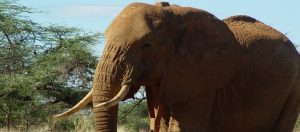
The science of wildlife monitoring is evolving rapidly and drones, wireless sensors, satellite communications and cloud computing are all becoming common tools in the conservationist/ecologist’s toolbox. Next month, I will be commencing a Postdoctoral fellowship at Colorado State University to concentrate on these research topics full-time.
Save the Elephants has been at the forefront of this new technology ever since the first deployment of Global Positioning System (GPS) collars onto elephants by Iain Douglas-Hamilton in 1995. Recently we implemented a cloud-based monitoring system for analyzing the movements of tracked elephants in real-time.
The real-time monitoring (RTM) system algorithms work tirelessly to watch for both interesting movement behaviour or signs that an elephant might be in trouble. In the event that a condition of interest is identified, alerts are sent to the STE team, the Kenya Wildlife Service and community conservancy security partners to take the necessary action.
The future
Based on the early success of our system, we are planning some major developments and expansion over the next year that will further extend its capacity. Samburu, in Northern Kenya, is the landscape in which we test these systems, but they have potential application across the continent.
Firstly, Save the Elephants are partnering with Google to integrate near real-time imagery from their new Skybox satellites to provide weekly updates of environmental conditions across the Samburu ecosystem. The Skybox imagery will help us monitor both drought conditions and vegetation dynamics which are important drivers of elephant and human movement dynamics.
Some of the Real-Time Monitoring algorithms I wrote process the imagery will identify alert conditions with regards to vegetation phenology and water availability that could predict elephant distribution or security in Northern Kenya. The Skybox imagery will also help us monitor the expanding human footprint within the elephants’ range and in relation to future developments such as a proposed oil pipeline and railway connection to a new port being built on the coast, in Lamu.
Creating sustainability
We are also planning to partner with the Seattle-based company established by Paul Allen of Microsoft — Vulcan Inc. — to develop the Real-Time Monitoring system into an open-source project. Making the system open-source will promote collaboration and help ensure longevity compared with proprietary code that has a natural shelf-life in the face of evolving technologies.
We hope that with Vulcan’s help, we can establish a community of users and developers who are all contributing to making the Real Time Monitoring system better, keeping the primary focus of protecting elephants and other wildlife at the heart of the system.

